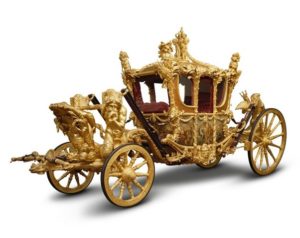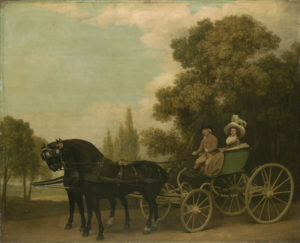This post was contributed by Ben Jackson, here at the University Birmingham. It is part of our Magical Source series, in which historians from Birmingham and Warwick discuss the sources that reshaped their thinking on a topic. The first entry, by Karen Harvey, was about Mary Toft’s Confessions. The second, by Charles Walton, was about Paine’s Letter to Danton.
Ben Jackson on Lord Grantham’s Coach
During my PhD, I spent a number of days working through the family correspondence of the Yorkshire lesser nobility family the Robinsons at the ‘Wrest Park Collection’ at Bedfordshire Archives and Record Services. My magical source is a letter sent by the British diplomat in Spain Thomas Robinson, Lord Grantham to his brother Frederick (Fritz) Robinson in London in March 1779. The letter details the social and cultural life of the Spanish court as well as the Robinson family back in England. The conspicuous discussion of material goods in the letter is representative of the brothers’ correspondence generally – this is both in part down to the brothers’ intense personal interest in art and furnishings and a semi-professional interest as Frederick acted as Grantham’s secretary and agent. In the run of 301 Grantham and Frederick’s letters in the archive, hundreds were concerned with material things – this is magical in itself. When reading through the collection, a phrase really stood out to me from this letter discussing Grantham’s ambassadorial gala coach used on formal processions into the Spanish royal palaces. Grantham wrote: “my Coach & Buff Harness are shabby to a degree & I determine whether I can do anything to be merely decent at [the Palace at] Aranjuez. You may think that I have no ambition to make a figure, at the same Time I must keep up appearances.”
‘To make a figure’ was at once a very antiquated phrase, but to ‘keep up appearances’ also felt incredibly modern – it reminded me of ‘keeping up with the Jones’ or indeed, the 1990s BBC Sitcom ‘Keeping up Appearances’ – a show about the snobbish and aspirational lower middle classes who compete over the granularity of class difference. Finding the ‘making a figure’ in Grantham’s correspondence made me think about its wider deployment in the vast social commentary on eighteenth-century luxury, consumer society, gender, and commodity culture.
The idiom ‘making a figure’ was often used to talk about middling peoples’ supposed aspirational desire for material luxury however this usage of the phrase didn’t quite fit with the elite, wealthy, noble ambassador whose hundreds of letters I’d been reading. For Grantham, shabbiness, decency, and maintaining appearances were more about fulfilling expectations placed upon him rather than an aspiration to consume and live beyond his station. My article, currently in revision, ‘To Make a Figure in the World: Identity and Material Literacy in the 1770s Coach Consumption of British Ambassador, Lord Grantham’, explored both the phrase ‘making a figure’ in eighteenth-century culture and Grantham’s own use of the term in ordering his ambassadorial coach for his formal entry into Spanish court life when he arrive in 1771. These were elaborate and iconographical coaches, and Grantham’s coach was probably only comparable, but in no way as magnificent as, the Gold State Coach.

As a historian interested in gender and materiality I began to think about how Grantham used his material knowledge of carriage design to negotiate the often-conflicting pushes and pulls that elite office-holding had men’s identities and material cultures. Grantham bought his coach out of his own purse but to use as a national representative on a global stage. A series of letter to Frederick detail Grantham’s anxieties and frustrations surrounding ‘making a figure’, my article argues for the importance of material culture and material literacy in the construction and negotiation of a professional (specifically diplomatic), social, and gendered identity in the late eighteenth century. Grantham didn’t like his coach, he thought it a showy, gaudy extravagance and said it was the only thing he regretted having bought. In terms of his personal carriage consumption, Grantham’s letters reveal he much preferred the phaeton, a more streamline, plain, faster, and more fun to drive vehicle.

“A Gentleman driving a Lady in a Phaeton,”
1787, NG3529
These two examples of carriages Encapsulate the tensions between Grantham professional identity as national representative and his personal identity as private gentleman and helpful materialise the conflicts between self, identity, and material display. My article challenges consumer history’s teleological propensity to think about consumption as an expression of an authentic or aspired selfhood and that consumers had identified pretty coherently with the goods they purchased. While Grantham’s material culture enabled him to display this kind of coherent process. Objects were integral to early modern diplomatic identity-formation – it was an appearance, a material performance and that was difficult and frustrating for Grantham. This case study makes us think more about how material goods worked to materialise some form latent material desires or coherent projections to others about the self.
In attempting to question the neatness of this characterisation of material selfhood post-PhD, I reflected on my own doctoral work on men’s relationship with their material goods and their motivations for consumption and material display. Indeed, this relationship between ‘the self’ and social identities has inspired my thinking behind my new project on the clergyman and how they negotiated the intersections of religious identity, gender identity, professional identity.
One final thing to say about this why is this source magical. I did the bulk of this research as a funded PhD student and was immensely privileged to be able to spend days and days in the archive at Bedford with the material having read hundreds and hundreds of letters between him and Frederick but also with his other siblings, relations, and friends. After the PhD as a Teaching Fellow at Birmingham with supportive and engaged colleagues, I was able to focus on this source and write an article. This meant that my historian’s institution was sparked when researching the phrase’s wider usage as every time a new definition came up in my research it just didn’t fit into Grantham’s use. So, while the source was magical, it was also magical because I had the time and resources to work with it.
